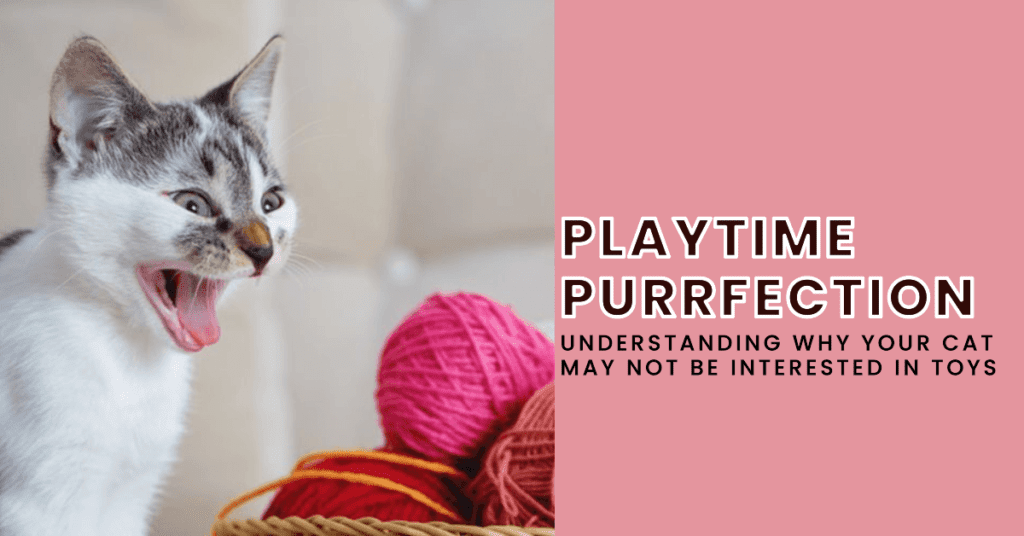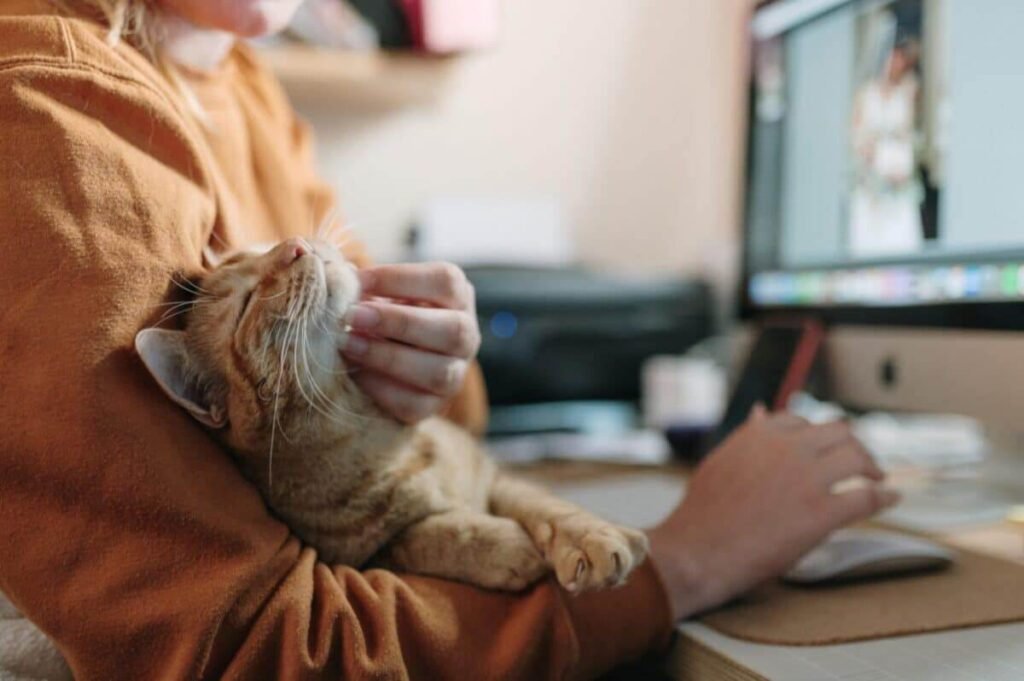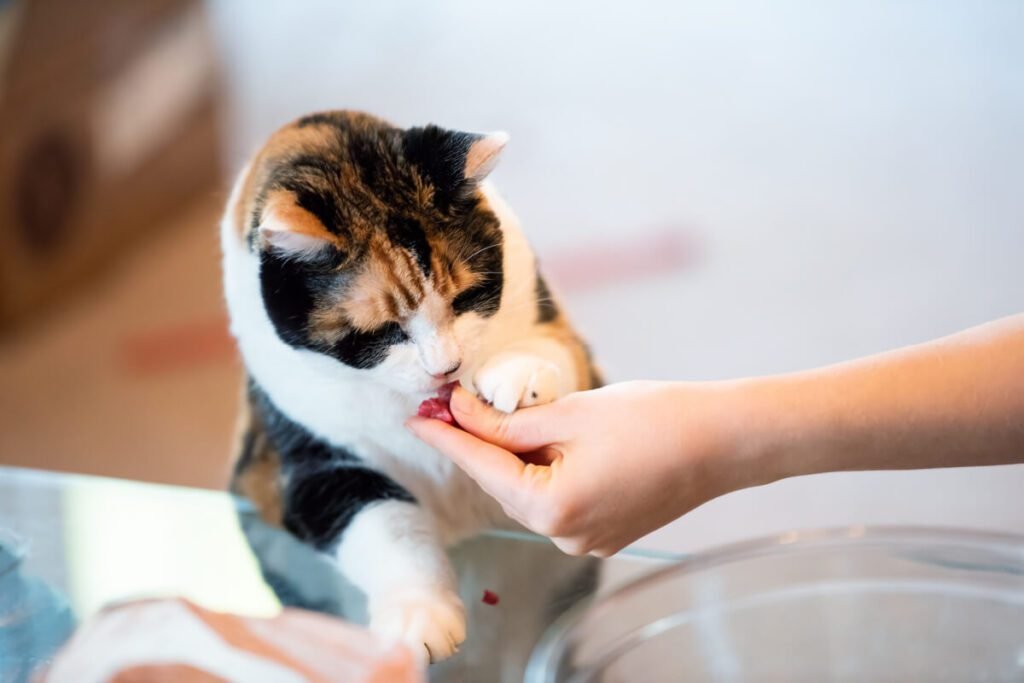Table of Contents
Cat owners can be frustrated when their felines don’t show interest in their playthings. What can we do to make them play? Let’s explore tips for engaging cats in playtime, so they can be happy and mentally stimulated.
Cats are curious, but not all toys capture their attention. Experiment with different types – some like soft toys, others chasing balls or dangling objects. Place the toys in their favorite spots. No distractions or stressors should be nearby.
Understand every cat is unique. Some may be more active at certain times. Others need gentle encouragement or interactive play. Watch their cues and adapt your approach.
Lilly, as featured on the Beacon Pet blog, used to be a lethargic cat with no interest in store-bought toys. However, everything changed when her owner stumbled upon an old feather wand tucked away in a closet.
As soon as Lilly spotted it, her eyes lit up with excitement, and she enthusiastically pounced on the feather. This simple discovery transformed her playtime experience, bringing joy to both Lilly and her owner. It goes to show that sometimes, the most unexpected items can become the perfect source of amusement for our beloved feline companions.
Understanding the Reasons Behind Cats Not Playing with Toys
Cats not playing with toys could be due to several reasons, which may come from their natural instincts and likes. By knowing these reasons, cat owners can find alternative ways to entertain their feline friends.
When it comes to choosing the best interactive cat toy, it’s important to consider your feline companion’s individual preferences. Cats, like humans, have unique tastes when it comes to playtime.
Some cats may be drawn to interactive toys that resemble prey, allowing them to engage in their natural hunting instincts. On the other hand, some cats might prefer toys they can swat and chase, providing them with a different form of stimulation. By understanding your cat’s specific preferences, you can select the most suitable interactive toy that will captivate their interest and provide hours of entertainment.
Plus, cats need mental and physical stimulation. If their toys don’t have variation or are not exciting, cats may lose interest quickly.
Also, cats can link certain toys to bad experiences, and thus, avoid them. For example, if a toy hurt or made them feel uncomfortable, they may be hesitant to play with something similar in the future.
In addition, health problems can stop cats from playing. It’s important to make sure their health is okay before anything else.
Kittens that didn’t have proper socialization may not be interested in toys either. Socializing is essential for kittens to learn and practice play.
Age, breed, and individual personalities can also affect cats’ willingness to play with toys. Every cat is different and could need different stimuli to enjoy playtime.
Once, I had a similar experience where my cat wouldn’t play with any toy. After watching her behavior, I noticed she was scared of bell sounds due to a bad experience with a bell toy. To fix this, I introduced her to toys with different sounds, and eventually, she liked playing again. It’s essential to know that each cat is unique and solving issues may take some time and tests.
By recognizing why cats don’t play with toys, cat owners can come up with suitable solutions to provide a happy life for their fur babies. By satisfying their individual needs and likes, cats and owners can have fun together during playtime.

Assessing the Cat’s Interests and Preferences
It’s key to grasp your kitty’s likes and dislikes, to guarantee their joy and health. Here are a few points to take into account when assessing your feline buddy’s interests and choices:
- Check their conduct: Notice how your cat interacts with its environment. Do they show enthusiasm for certain items or activities? Look for any patterns or tastes.
- Test different toys: Offer a selection of toys for your cat to play with. Attempt interactive toys, catnip ones, or puzzle toys to spark their curiosity. Note which toys draw their attention the most.
- Think about their breed and age: Various cat breeds may have specific choices when it comes to play. Kittens, for instance, may take pleasure in more energetic and playful activities compared to older cats. Alter the types of toys accordingly.
- Customize the environment: Put together an interesting environment that matches your cat’s interests. Include scratching posts, climbing structures, or cozy resting spots depending on their preferences. This will motivate them to explore and play.
- Bond through playtime: Employ play as a chance to strengthen the bond with your cat. Interact with them using wand toys or feathers attached to strings. Participate in interactive play sessions frequently.
- Ask for expert advice: If you’re uncertain what toys or activities would suit your cat best, consult a vet or an animal behaviorist. They can offer advice based on your pet’s particular needs.
Keep in mind that each cat is exceptional, so take time to comprehend what sets your furry friend apart. Examining their interests and choices will help you produce an enriching environment tailored specifically for them.
Pro Tip: Regularly rotate the selection of toys accessible to your cat. By introducing new options often, you’ll keep them involved and evade tedium with the same old playthings.

Creating a Stimulating Environment for Play
Engage your cat with toys by crafting a stimulating atmosphere! Keep these tips in mind:
- Diversity is important. Provide a range of toys, such as interactive puzzles, feather wands, and balls.
- Switch up the toys often to prevent boredom. This way, your cat won’t get tired of the same toys.
- Put the toys in areas where your cat can easily access them. This encourages exploration and interaction.
- Sprinkle catnip or other scents on the toys to make playtime more interesting.
- Set up special play areas with scratching posts, climbing structures, and hiding spots.
- Interact with your cat using laser pointers or wand toys. This strengthens the bond between you and entertains your kitty.
Also, provide opportunities for solo play that mimic hunting behaviors. Feeders or treat-dispensing toys are great options.
Reward your cat with treats or praise when they play with toys. This reinforces positive behaviors.
Remember, crafting a stimulating environment not only enhances physical health, but also improves mental well-being. Have fun!
Encouraging and Rewarding Play Behavior
Encouraging and rewarding play in cats is essential for their physical and mental well-being. Through interactive play, the bond between you and your feline friend can be nurtured, while allowing them to express their natural instincts. Here are some great techniques to encourage and reward play:
- Pick the right toys: Select toys that fit your cat’s taste, like puzzles, feather wands, or stuffed toys filled with catnip.
- Schedule daily playtime: Assign a specific time every day to actively play with your cat. Maintaining a routine will make them anticipate playtime.
- Use positive reinforcement: Reward your cat with treats or verbal praise when they interact with toys or actively join the play. This will build an association between playtime and positive outcomes.
- Vary the play techniques: Try different play styles, such as running, hiding toys, or imitating prey behavior. This will keep the sessions interesting and fun for your cat.
- Rotate toy selection: To keep your cat interested, change out toys regularly. Put some away for a few weeks, then reintroduce them.
- Consider interactive feeders: Use food-dispensing toys or puzzle feeders during play sessions. This will provide an extra incentive for your cat to play, while satisfying their hunting instincts.
Apart from the techniques mentioned above, it is important to remember that each cat is unique. Observe which toys and activities your cat enjoys the most, and adjust accordingly. Patience and diligence are essential when teaching reluctant cats to play.
Pro Tip: Monitor your cat’s energy levels throughout the day, and schedule play sessions when they are most active, like in the morning or evening. This way, you can make the most of the playtime.
Check out the Beaconpet blog for a variety of homemade toys for cats!

Seeking Professional Help if Needed
If your cat shows no interest in playing with toys, seeking professional help is a good idea. Here are five points to ponder:
- Ask a vet to check for medical issues.
- Hire an animal behaviorist.
- Search for experienced cat trainers.
- Try holistic therapies like acupuncture or aromatherapy.
- Join support groups and forums.
Note: Professional help can offer tailored solutions for your cat’s needs. Patience and persistence are essential when seeking aid for your kitty. Keep in mind that what works for one cat may not work for another!

Conclusion
In conclusion, if your cat isn’t interested in playing with toys, there are some tips to try:
- Experiment with different types of toys to find what they prefer.
- Incorporate playtime into their routine.
- Provide a variety of toys in different textures and shapes.
- Use treats or catnip to entice them during playtime.
- Get interactive with toys such as wands or feather teasers.
- Create a safe and stimulating environment with plenty of vertical spaces.
- Find the right toy that appeals to their instincts.
- Patience and understanding are key since cats have unique preferences.
- Explore different options until you find something your feline companion loves.

Frequently Asked Questions
1. Why won’t my cat play with toys?
There can be several reasons why your cat is not interested in playing with toys. It could be due to a lack of stimulation, boredom, a health issue, or simply a personal preference. Observing your cat’s behavior and consulting with a veterinarian can help identify the underlying cause.
2. How can I encourage my cat to play with toys?
There are a few things you can try to encourage your cat to play with toys. Firstly, provide a variety of toys that cater to your cat’s preferences, such as interactive toys or those resembling prey. You can also try using catnip or treats to make the toys more enticing. Additionally, spending quality playtime with your cat by engaging them in interactive play can help stimulate their interest in toys.
3. What types of toys are best for cats?
Cats have different preferences, so it’s important to offer a variety of toys to find what your cat enjoys. Some popular toy options include interactive toys, puzzle toys, feather wands, laser pointers, and toys filled with catnip. Trying different textures, sizes, and shapes can also help determine what type of toys your cat responds to best.
4. Are there any alternatives to traditional cat toys?
Absolutely! While traditional cat toys can be fun, some cats may prefer alternative objects to play with. You can try providing household items like crumpled paper balls, empty cardboards boxes, or even ping pong balls. Just ensure the objects are safe and don’t have any small parts that could pose a choking hazard.
5. Could my cat’s lack of interest in toys indicate a health problem?
Yes, it’s possible. A sudden change in your cat’s behavior, including a disinterest in toys, could be a sign of an underlying health issue. Cats can experience pain or discomfort that affects their playfulness. If you’re concerned, it’s best to consult with a veterinarian to rule out any medical conditions.
6. What if my cat still won’t play with any toys?
If your cat continues to show no interest in toys, it’s essential to ensure they are well-stimulated in other ways. Provide opportunities for exercise through climbing trees or perches, offer scratching posts, and engage in interactive play with your cat using items like feathers or string. Sometimes simply spending quality time with your cat is more important than toys.